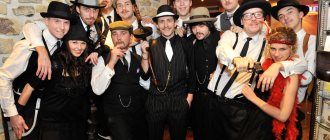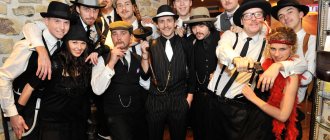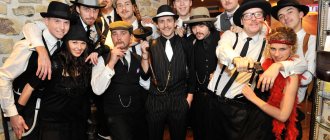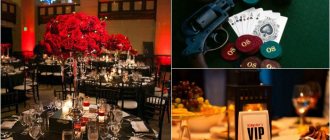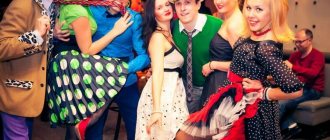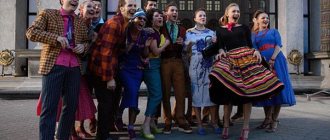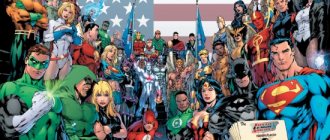Is there a holiday around the corner again? Let's throw away the usual stereotypes and bring some intrigue! Let your guests have a blast at your Mafia-themed party! What associations do you have with the word mafia? Danger, revenge, weapons, riches, the godfather, Sicily - carry on! All the words tickle your nerves and beckon you to take a peek into this forbidden world. A great opportunity for one evening to transform from a law-abiding citizen into a risky adventurer walking on the edge of the blade. Feel like an “outlaw” - it’s all a Mafia-style party!
This party is suitable for young and playful people who want to really “have a blast.” It is somewhat reminiscent of a Hollywood-style party, in which guests must also come in smart suits and evening dresses.
Mafia surroundings: preparing invitations
Start creating a party atmosphere with the invitations. Send emails to all guests with a themed picture (card style - money - two barrels). If desired, draw it yourself in a graphics editor. Sign something like “Weapons allowed.”
If you prefer to present invitations in person, you can make them in the style of a 1930s newspaper. This is done very simply: a sheet of paper is kept in strong black tea to give it the characteristic color of an aged newspaper. Then, when the paper is dry, write the text with black paste or a felt-tip pen: “Phenomenal event! The dismantling of criminal clans... and... will take place at... at (indicate the start time of the party and address) Don’t miss it!” Also warn guests that they must arrive dressed as a mafioso. Have with you as many attributes as possible characteristic of representatives of the real mafia.
Dialogue and exposition
Inept writers often use dialogue merely to provide exposition. And this is the wrong approach.
You've probably come across such dialogues yourself - where the characters for some reason discuss what they already know. Where, say, old friends, without any reason, remember how long they have been friends. Such dialogues sound unnatural - obviously, these characters would never talk about such things. It is not they who need the conversation, but the viewer. Or rather, even the author who couldn't figure out how to deliver the exposition in a less obvious way.
Good dialogue is not about exposition. It's about characters. The viewer should feel that the characters on the screen are speaking on their own behalf, and not on behalf of the scriptwriter.
Moreover, the actors must feel this, otherwise the hero simply does not come out. It turns out to be a cardboard figure, a character whose function in the plot is so obvious that it instantly takes you out of immersion in the story.
Of course, exposition can and should be revealed through dialogue - after all, the backstory of the characters is difficult to tell otherwise. But in a good script, all this happens in a veiled way, so that the conversation does not seem like a meager news report to the viewer. Through dialogue we get to know the characters, understand how they think, how they behave, and what relationships they have with other characters. And somewhere behind all this we learn information about the plot - as if by chance, in between times.
"12 Angry Men"
Sometimes it’s so casual that the audience doesn’t even think about the meaning of the scene. They often say about Quentin Tarantino’s films that in them people chat about “nothing,” but for some reason it’s still very interesting to listen to. The fact is that Tarantino’s dialogues are an excellent example of meaningful dialogue, written according to all the rules of dramaturgy.
Take the conversation between Vince and Jules in one of the first scenes of Pulp Fiction. The two characters really seem to be talking about anything except things that are really important to the plot: the name of burgers in Europe, foot massage. But all this is actually very important for the story.
From Vince's story about the Royal Cheeseburger, we learn that he ran one of Marcell Wallace's establishments in Amsterdam. This means that they trust him, he is an important member of a gangster group, firmly entrenched in the criminal environment. The conversation about foot massages communicates to the viewer that Wallace is an extremely cruel and jealous type, thus increasing the tension in future scenes where Vince is forced to spend the evening with his boss's wife. We know what's at stake, and we sense that sexual attraction between them could lead to dire consequences.
From the same dialogue, we learn that Jules is not too happy with his life - he questions the actions of his boss, albeit in a comical context. Later, after a miraculous rescue, he truly realizes that he can no longer be part of the gang.
It may seem that this is unnecessary “chewing”, an empty explanation of what is already clear. But this is “already understandable” precisely because of how skillfully Tarantino writes dialogue. We really understand everything about his characters from one conversation - although they don’t say anything about themselves, don’t turn themselves inside out in front of the viewer and each other. Vince could have said, “Listen, my boss asked me to keep an eye on his wife, and I'm scared because he recently threw a man out of a window for giving her a foot massage.” And Jules would answer him: “Yes, our boss is too cruel, in my opinion. I’m thinking about going to hell.” And it would sound fake. Because people don't talk like that, they rarely talk about their feelings directly.
Party in the style of "Mafia" - dress code
At the beginning of the party itself, meet all guests at the entrance and conduct a comic search for weapons and prohibited substances. If nothing incriminating is found during the search, hand such a guest something from the list:
- cigar pistol;
- a bag of white powder;
- wooden knife;
- handcuffs;
- toy pistol;
- wallet with paper bills (can be printed in advance);
- other types and attributes of “mafiosi”.
Only then invite guests to enter. The dress code is also very important at a Mafia themed party.
Dualogue and trialogue
Robert McKee distinguishes two types of dialogue: dualogue and trialogue. Dualogue is when two characters communicate exclusively about each other. According to McKee, such talk usually comes off as insincere and is more often associated with bad melodrama. In them, the characters can really share their feelings with each other for several minutes, but that's the point. As soon as you turn a deep feeling into words, it loses all power and becomes superficial. After all, if this feeling is so easy to express, it means there is no depth in it.
Judging by the title of the trialogue , it may seem that we are talking about conversations in which three characters participate - but everything is somewhat more complicated. Yes, it really does mean the presence of something “third”, but not in the literal, not in the physical sense. McKee writes that in trialogues the characters do not talk about each other, even if, say, they sort things out. There is always something third, some topic, event or character, through the discussion of which the personalities of the characters are revealed and the conflict moves in the plot. In the case of Pulp Fiction, it's the third - foot massage, Royal Cheeseburger or Marcellus Wallace.
Let's take other examples. In "Low Down in Bruges" the characters talk about architecture, Tottenham, dwarfs and bowling, but through these conversations the viewer learns about the deepest trauma of Colin Farrell's character. In Sunset Limited, a film built entirely on dialogue, the characters of Tommy Lee Jones and Samuel L. Jackson discuss religion, art, prison, and through these conversations we learn about their worldview. Only when the audience is ready and immersed in the subtext do the directors allow their characters to talk about what really worries them: in the case of "Lie Down in Bruges" about the boy killed by Ray, in the case of "Sunset Limited" - about the strong intention of the hero Lee Jones commit suicide.
In these moments, McDonagh and Sunset Limited writer Cormac McCarthy inject exposition into the dialogue, but for a reason. They use “exposure as a weapon,” another McKee term. That is, plot information is not just dryly offered to the viewer as a fact, but appears precisely at the moment when the viewer is already immersed in the story and knows the characters. When he is involved and therefore vulnerable.
The most famous example of exposition as a weapon is Darth Vader's I Am Your Father. George Lucas could have communicated Luke's relationship to his enemy in a thousand other ways, but he did it at the most pivotal moment. And that’s why the revelation has such a powerful effect on the viewer.
Female image at a party in the style of "Mafia"
Watch at least one film about the mafia: “Gangster”, “Don. Mafia leader." This will become your guide. The gangster's girlfriend is the so-called femme fatale, seductive and inaccessible. She attracts with the aroma of expensive perfumes and dazzles with the shine of jewelry. The dress definitely emphasizes the figure and invites an open neckline. As for materials, give preference to silk or velvet - they look very noble. Fringe along the bottom of the dress would be very appropriate. Complete the look with accessories:
- a lush boa made of bird feathers;
- a pair of long lace or patent leather gloves;
- black fishnet stockings;
- fur cape;
- a headband with flowers or feathers;
- small pillbox style hat;
- don’t be afraid to wear lots and lots of jewelry: bracelets, rings and necklaces.
And for a woman who is courageous and has an adventurous nature, I suggest trying the image of a gangster herself. Such a woman is not content with a supporting role. She does everything herself and keeps several dozen men at bay. Dress in tailored trousers, add suspenders and a crisp white shirt. A small tie (imitation men's) and a hat will look good in this image. The final accent is the pistol on the belt.
Men's outfit for a Mafia themed party
- This is, of course, a business suit combined with a shirt and tie (if you don’t like ties, choose a bow tie). Ideally in black and white.
- On her feet are patent leather shoes with pointed toes.
- Smooth your hair with gel to create the effect of wet hair.
Well, some characteristic details:
- cigar;
- gold watch;
- cufflinks with stones;
- hat on the back of the head;
- gun.
Party room interior
You need to decorate the room where the Mafia-style party will take place with taste: the Mafia does not buy consumer goods or tasteless furniture.
- decorate indoor furniture with fabric;
- hang old newspapers on the walls (you can make them yourself, just like invitations);
- several photos of Chicago and Los Angeles at night.
Background music – jazz, blues, reggae.
Evening menu
The motto of this evening’s menu should be the expression “expensive and rich.” The mafia does not eat simple food and does not drink cheap alcohol. This doesn't mean you need to spend your last cash on snails from France and $1,000 champagne. Chic, as we know, is in the details:
- snow-white tablecloth;
- shiny dishes;
- fancy folded fabric napkins;
- cards with guest names;
- If possible, silverware and thin glasses.
Try to keep the entire menu in Italian style:
- for main course - pasta with Bolognese sauce;
- mini pizza for snack;
- risotto;
- various salads.
If you don't like Italian cuisine, that's okay - serve the meat the French way. Despite its triviality, this dish is loved by many and looks appropriate on any table. Complete the menu with a couple of original salads.
From drinks:
- gin;
- whiskey with ice;
- champagne;
- various cocktails.
Don’t be afraid to come up with themed names for your cocktails, like “Baron’s Revenge” or “Control Shot.”
Games during the party
Shall we play? Well, of course, this is the immortal game “Mafia”. Who doesn’t remember the sacramental “the mafia wakes up”! Before the party, read the rules of the game. It is advisable to even print it out to read to your guests (as the rules may vary in each guest's mind).
To play you will need:
- masks (make from paper) or just scarves for blindfolding;
- cards that can be taken in the board game “Mafia” buy the board game “Mafia” here. Choose any option!
Try throwing money down the drain - the mafia’s favorite pastime (after a showdown, of course). Stock up on counterfeit bills (you can buy them in the office supply or souvenir department).
Have a competition to see who can blow the next bill off their palm. You can have guests tie a bow with their hands cuffed. You can compete in shooting with a toy gun. Lots of opportunities for fun!
Don't forget, of course, to take pictures. To do this, decorate a photo zone in the “Mafia” style.
Photos from a Mafia themed party will remind you more than once of the fiery evening and lift your spirits.
What can't be said
Robert McKee wrote that every hero has three realms of existence: the spoken, the unspoken, and the unspoken. What is said is what the hero says. But he may feel something completely different from what he expresses out loud. May hide feelings deep inside. Maybe he's just lying.
The unspoken is what the hero actually feels. This is not in the text, this is not written in the script. But in a good dialogue, the viewer still reads the unspoken - he sees, as it were, through the hero, realizes his aspirations, goals and desires. And it doesn't just work in complex dramas.
When Sean tells his girlfriend in the first scene of Sean of the Dead that he's taking her to "a place where everything is fish," he doesn't say out loud that he loves her very much and is willing to step out of his comfort zone for her. stuck so firmly and for a long time. He doesn’t talk about how difficult it is for him and that he most likely won’t keep his promise. But we understand this: from the tone of the conversation, from the words he chose, from the subtext.
And finally, there is the unspoken . What lies deep in the hero’s subconscious, what he cannot express in words. This is the most complex and deep level that cannot be “calculated”: you can only feel it.
In Lost in Translation, Sofia Coppola builds the entire film around an unspoken feeling. A special type of loneliness for heroes who find themselves far from home. They have someone to talk to, but they still don’t have the opportunity to express everything that’s in their hearts. They themselves do not understand what is in their soul.
Local dialogues are a triumph of the unspoken. When Scarlett Johansson and Bill Murray's characters first meet in a bar, they seem to be just flirting and ironically complaining about life. And yet, in their conversation there is that same unexpressed feeling that will later bring them closer together.
It’s not for nothing that Bill Murray delivers the main, climactic line in “Lost in Translation” in a whisper, in your ear. The viewer never hears what he said at all. Because it doesn't matter. This cannot be put into words - you can only create a feeling through dialogue, but not formulate it in any way.
A screenwriter who writes dialogues doesn’t just think about how to succinctly fit important plot points into words. He works as a psychologist. After all, when psychotherapists listen to people lounging on their beds in their office, they always write something down in a notebook. But they don’t write the patient’s story there word for word—that is, as expressed. What is in the notebook is unspoken. And this unspoken is needed in order to try to record the unspoken.
